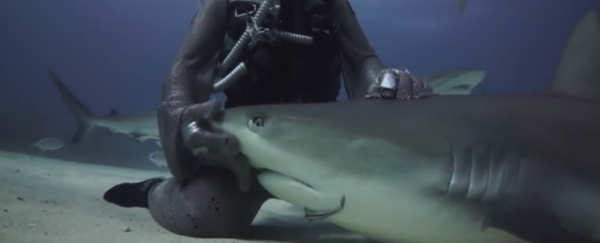
It might look like this shark just enjoys getting some nose scritches, but the science behind this behaviour is actually a whole lot more complex and fascinating.
It's called a tonic state, or tonic immobility, is a fairly common natural behaviour found in many species of insects, amphibians, birds, reptiles, mammals, and fish, usually in response to fear or a threat. In sharks, the triggers are a little more ambiguous - flip them on their back and they're likely to fall into a state of paralysis, or rub them on the snout for a more gentle response - and researchers have suggested that perhaps rather than being a fear response, it actually evolved to help facilitate mating.
When sharks mate, the male will use his teeth violently grab the female by her side - or pectoral - fins, and hold her in place. This behaviour often leaves deep, long-lasting scars in her flesh, which is why female sharks have skin that's twice as thick as the males'. At this point, the female must decide whether she feels strong enough to escape, or if she will submit to the barrage of bites and scratches that accompany copulation.
While no one has specifically studied the association between tonic immobility and mating in sharks, a number of reports have found that when a female submits, the male will flip her onto her back to induce the tonic immobility, making the process of penetration a whole lot easier.
You can see an example of it here:

Flipping a shark to induce the behaviour is so effective, that a few years ago, the National Geographic Channel reported on an eyewitness account of a female orca taking advantage of it to make an easy meal out of what could be a great white shark. It's not clear whether the orca knew what she was doing, but she managed to hold the shark upside-down, causing it to slip into tonic immobility. The state lasted for 15 minutes, before the shark suffocated to death.
The documentary also reported another account of orcas inducing tonic immobility off the coast of New Zealand, where they would attack stingrays while upside-down. This means that when an upside-down orca has caught a stingray in its mouth, and it flip itself over, and the stingray will now be upside, in a tonic state, and easier to kill and consume.
Researchers also take advantage of the relative ease of inducing a tonic state in a shark or a stingray, and have used it to study species such as the Spiny Dogfish, the lemon shark, the leopard shark, the blacktip and whitecap reef sharks, the California round ray and the southern stingray. But in her video above, Italian shark trainer and diver Cristina Zenato says it's harmless, not forceful, and doesn't worry the shark. In fact, you can a female nudging her snout into Zenato for more, perhaps because this part of her body is filled with sensory organs, and she likes how the scratches feel.
Researchers who use the technique on sharks have also found that the females are far more receptive to it than the males, which fits with the theory that it evolved as a mating strategy.
And now, because it's too strange not to share, here's what happens when a subreddit about Tsundere sharks (just read about it here, it's too weird) gets their hands on it:

